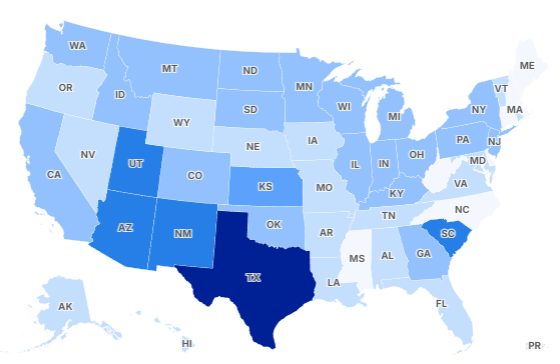As the political spotlight intensifies across the United States ahead of this Tuesday’s pivotal gubernatorial elections, a stunning new poll has shed fresh light on how the American public currently views two towering political figures: former President Barack Obama and current President Donald Trump. With tensions mounting in the lead-up to the 2026 midterm elections, the results reveal a clear public preference—and it’s not in favor of the sitting president.
Voters in Virginia and New Jersey are preparing to head to the polls on Tuesday, November 4, with both states hosting critical races that could influence the balance of power at the state and national level. In the build-up to election day, big political names have been making their final pitches to voters, including Barack Obama, who returned to the campaign trail for a pair of high-profile rallies over the weekend.
The 44th President of the United States made appearances in Newark, New Jersey, and Norfolk, Virginia, on Saturday, November 1, speaking on behalf of Democratic candidates Mikie Sherrill and Abigail Spanberger. Both candidates are believed to be competitive in their respective gubernatorial contests, with polls suggesting they have a solid shot at victory. Yet it was not just their campaigns that drew attention—it was Obama’s direct criticism of the current administration and the broader state of politics in America.
In a fiery departure from what some might have expected to be the mild tone of a rested statesman, the 64-year-old former president launched a searing critique of Trump’s leadership. Obama accused Trump’s administration of promoting policies that are “worse than even I expected,” suggesting that the president has actively undermined free speech, demonized immigrants, and jeopardized public health. He also criticized the deployment of the National Guard to cities in what he described as an overreaction to “crime waves that don’t actually exist,” accusing the administration of stoking fear to score political points.
Obama’s speech came just as a new poll out of Marquette University revealed that the former president remains more popular than Trump among the American public. The survey polled 1,005 adults nationwide between September 5 and 24 and found that 57 percent of respondents viewed Obama favorably, while only 40 percent held an unfavorable opinion. That gives Obama a net favorability rating of +17.
In contrast, the current president’s numbers are notably less favorable. Just 42 percent of Americans expressed a positive view of Trump, while 57 percent said they held an unfavorable view—placing him at a net favorability rating of -15. The significant gap between the two men highlights a dramatic shift in how Americans evaluate presidential leadership, even years after Obama left office.
Political expert Meena Bose, executive dean of the Peter S. Kalikow School of Government at Hofstra University, believes the survey underscores the lasting power of Obama’s image and legacy. “Obama’s personal appeal, inspirational rhetoric, and unanticipated success in the 2008 presidential race continue to have strong public support,” she told Newsweek. She explained that the message of “hope and change,” which defined Obama’s successful 2008 campaign and much of his presidency, still resonates with a significant portion of the electorate.
However, it isn’t just a simple contest between two men. The Marquette poll also evaluated how Americans feel about every president since Ronald Reagan. And while Obama ranks high, he isn’t the most popular. That honor still belongs to Ronald Reagan, who remains the most favored modern president according to the survey’s findings, earning a net +28 rating. Biden, Obama’s former vice president and the 46th president, placed at the bottom of the list with a shocking net favorability of -24.
The poll results suggest that Donald Trump’s presidency is viewed less favorably than even some of his Republican predecessors. George H.W. Bush scored a solid +17 rating, while both Bill Clinton and George W. Bush shared a +8 favorability. Joe Biden’s dismal performance is perhaps the most surprising, especially given his one-term tenure and early exit from the 2024 election field. Bose speculated that Biden’s low rating could be a reflection of the public’s frustration over his decision not to seek reelection—a move that potentially skewed public perception of his overall presidency.
Obama, meanwhile, continues to enjoy a level of popularity that has proven surprising even to some political insiders. A Gallup poll published earlier this year found that he was the most popular living president, with 59 percent of respondents saying they viewed him favorably, compared to only 36 percent who felt otherwise. That ongoing support has positioned him as a powerful surrogate for the Democratic Party, both in state-level races like Tuesday’s and in the national discourse heading into the 2026 midterms.
The growing popularity gap between Obama and Trump offers fresh strategic fodder for both parties. Democrats have been working hard to tie Republican candidates to Trump across the country, banking on the opposition to the Trump administration energizing their base and swinging independent voters their way. For Republicans, the challenge remains to secure victories despite the increasing hostility of suburban and moderate voters who may be growing tired of the divisive rhetoric and polarization of Trump-era politics.
Micah Rasmussen, director of the Rebovich Institute for New Jersey Politics at Rider University, told The Mirror US that the GOP is facing a steep climb this election cycle. “The question is whether or not Republicans are doing enough this time to completely breach it or partially breach it,” he said, noting the size of the likely Democratic advantage in key districts. “I think even among the most nervous of Democrats, there’s no question that Republicans have to have a very big Election Day in order to overcome what could be as much as 250 or 275,000 vote margin for Democrats at this point.”
As election day approaches, the political temperature continues to rise. Obama’s pointed speech, the unveiling of new polls, and massive turnout efforts by both parties make this week a crucial one for the future direction of American politics. It’s not just about who wins in Virginia and New Jersey—it’s a sign of where the country stands in its division over leadership, values, and vision.
Whether Trump’s supporters can rally in time to shift the tide, or whether Obama’s influence can carry Democrats over the finish line, remains to be seen. But one thing is certain: the political dynamics between past and present presidents are playing a very real role in shaping the American electorate today.
As Trump continues to stir controversy and Democrats lean into Obama’s enduring popularity, this week’s elections could serve as a powerful preview of what’s to come—both in the 2026 midterms and beyond.

Emily Johnson is a critically acclaimed essayist and novelist known for her thought-provoking works centered on feminism, women’s rights, and modern relationships. Born and raised in Portland, Oregon, Emily grew up with a deep love of books, often spending her afternoons at her local library. She went on to study literature and gender studies at UCLA, where she became deeply involved in activism and began publishing essays in campus journals. Her debut essay collection, Voices Unbound, struck a chord with readers nationwide for its fearless exploration of gender dynamics, identity, and the challenges faced by women in contemporary society. Emily later transitioned into fiction, writing novels that balance compelling storytelling with social commentary. Her protagonists are often strong, multidimensional women navigating love, ambition, and the struggles of everyday life, making her a favorite among readers who crave authentic, relatable narratives. Critics praise her ability to merge personal intimacy with universal themes. Off the page, Emily is an advocate for women in publishing, leading workshops that encourage young female writers to embrace their voices. She lives in Seattle with her partner and two rescue cats, where she continues to write, teach, and inspire a new generation of storytellers.









